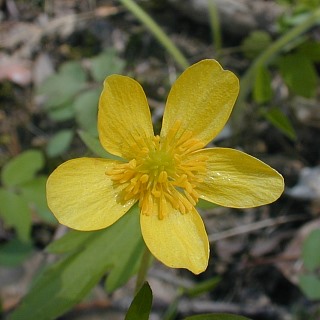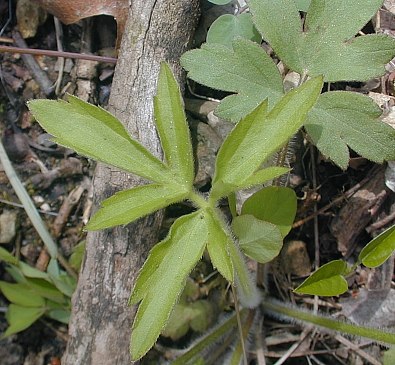Description:
This
perennial wildflower is up to 1' tall; it has a tendency to
sprawl with age. The stems are light green to pale reddish brown and
more or less covered with long spreading hairs. Both basal and
alternate leaves are produced; like the stems, their petioles are
covered with long spreading hairs. Sometimes, the petioles are as long
or longer than the compound blades of the leaves. The leaf blades are
usually trifoliate (divided into 3 leaflets). The leaflets are up to 4"
long and across and usually cleft into 3 lobes. The margins of
the
leaflets are irregularly dentate. The terminal leaflet has a short
petiolule (short stalk) at its base, while the lateral leaflets are
either sessile or they have even shorter petiolules. The upper surface
of each leaflet is
more or less medium green with scattered appressed hairs, while the
lower surface has spreading hairs along the major veins. The upper
leaves are smaller in size than the basal leaves and their leaflets are
often lack lobes. Occasionally, solitary flowers are produced on long
hairy stalks. These flowers are about ¾–1" across, consisting of 5
shiny yellow petals, 5 light green sepals, a dense cluster of pale
yellowish green pistils, and a ring of numerous stamens with yellow
anthers. Toward the center of each flower, the petals become
semi-translucent and each petal has several fine lines that function as
nectar guides. The sepals are hairy and lanceolate in shape; they are
shorter than the petals. The blooming period occurs from mid- to late
spring and lasts about a month. Each flower produces several flattened
achenes with long beaks; these achenes are up to 3.5 mm. in length. The
root system is fibrous. This wildflower reproduces by reseeding itself.
usually cleft into 3 lobes. The margins of
the
leaflets are irregularly dentate. The terminal leaflet has a short
petiolule (short stalk) at its base, while the lateral leaflets are
either sessile or they have even shorter petiolules. The upper surface
of each leaflet is
more or less medium green with scattered appressed hairs, while the
lower surface has spreading hairs along the major veins. The upper
leaves are smaller in size than the basal leaves and their leaflets are
often lack lobes. Occasionally, solitary flowers are produced on long
hairy stalks. These flowers are about ¾–1" across, consisting of 5
shiny yellow petals, 5 light green sepals, a dense cluster of pale
yellowish green pistils, and a ring of numerous stamens with yellow
anthers. Toward the center of each flower, the petals become
semi-translucent and each petal has several fine lines that function as
nectar guides. The sepals are hairy and lanceolate in shape; they are
shorter than the petals. The blooming period occurs from mid- to late
spring and lasts about a month. Each flower produces several flattened
achenes with long beaks; these achenes are up to 3.5 mm. in length. The
root system is fibrous. This wildflower reproduces by reseeding itself.
Cultivation:
The preference is dappled sunlight during the spring, followed by light
shade during the summer. This buttercup prefers mesic to dry conditions
and a rich loamy soil with some decaying leaves.
Range & Habitat:
The native Hispid Buttercup occurs occasionally throughout Illinois;
its
distribution is somewhat patchy (see Distribution
Map). Habitats include upland woodlands, wooded slopes, and
bluffs where oak trees are often present; unlike Ranunculus
septentrionalis (Swamp Buttercup), this species is rarely
found in damp habitats.
Faunal Associations:
Buttercups are the summer hosts of the aphid Thecabius
gravicornis. The seeds and foliage of woodland buttercups are
eaten by such upland gamebirds as the Wild Turkey and Ruffed Grouse;
the Eastern Chipmunk also eats the seeds. The foliage is toxic to
mammalian herbivores and usually avoided by such animals.

Photographic
Location:
An upland area of Warbler Woods in Coles County, Illinois.
Comments:
Hispid Buttercup and Ranunculus septentrionalis
(Swamp Buttercup) are very similar to each other. Hispid Buttercup
differs primarily by the long spreading hairs on its stems and
petioles, and its preference for drier habitats than Swamp Buttercup.
Swamp Buttercup is either hairless or it has short appressed hairs
along its stems and petioles. Some authorities regard these two
buttercups as different varieties of the same species. For spring
wildflowers, they bloom longer than average.